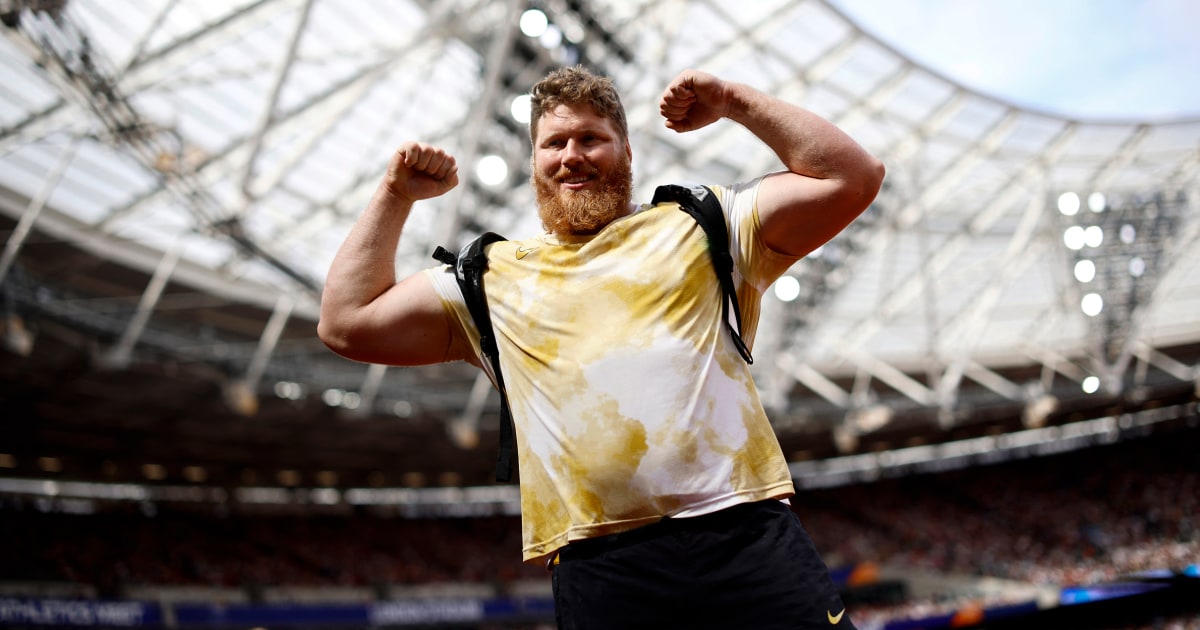PARIS — The best shot putter in track and field’s history spent this spring and summer experiencing something unusual: vulnerability.
It all started in March, when Ryan Crouser injured the ulnar nerve in his throwing elbow. The next month, while bench pressing, he tore a pectoral muscle.
Doctors didn’t clear him to resume throwing the 16-pound metal shot until almost June. By late July, in his final warmup before the Paris Olympics, the Oregon native was beaten for the first time in nearly a year.
“There were some challenges this spring,” Crouser said. “To say the least.”
When the 31-year-old American steps into the Stade de France ring in Saturday’s Olympic shot put final, it will be the ultimate test of a season he never would have predicted, one that has battered his body, if not his confidence. Because he could leave the night just as he’d imagined all along — as not only history’s farthest thrower, but its most dominant.
Follow along for live coverage
“I can’t do exactly what I could do day to day when I was younger,” Crouser said. “But I still believe at the top end I can still be as good as I ever was, if not better.”
Crouser left no suspense in Olympic qualifying Friday night, with his first and only throw of 70 feet, 6 1/4 inches automatically advancing him to Saturday’s final. It also meant less wear and tear on his body.
Crouser has made Olympic history before. His record-breaking throw earned him gold in Rio de Janeiro in 2016, then he reset that record three times while repeating in Tokyo. Should he win in Paris as well, it would extend his control over the event to an unprecedented three consecutive gold medals, breaking the two-gold tie he holds with Ralph Rose (1904, 1908), Parry O’Brien (1952, 1956) and Tomasz Majewski (2008, 2012). A win would also widen the gap between American success in the event and everyone else. In 29 Summer Olympics, Americans have claimed gold 19 times.
Crouser owns 11 of the 20 farthest marks of all time, all of which were thrown between 2021 and this season. Only four men have thrown past 75 feet, 5 1/2 inches (23 meters) — and Crouser has done it nine times. The three others have combined for five. It is not as though Crouser has won multiple Olympic and world championships while beating up on inferior competition, either. Throwers owning history’s second-, fifth- and seventh-best marks are part of the Paris field. The U.S. has an outside shot of sweeping the medal stand.
“Every year I think if I can get a little bit better, the sport will get easier,” he said, smiling. “But every year the guys seem to keep up with me and even gain a little bit, so it’s been hard to pull away, but it does keep it exciting.”
Crouser has maintained his hold on the event through a rare willingness to rethink a throwing technique that had already earned him gold in Rio and Tokyo. Self-coached, and with a background in engineering and a degree in finance, Crouser gets deeply analytical while practicing in his self-described “barn” near the University of Arkansas.
Fayetteville, Arkansas, is filled with professionals who often overlap at the Razorbacks’ track, but Crouser’s comfort tinkering alone and his stature within the sport create a deference even other world-class athletes acknowledge.
“I don’t really talk when I see him training because he’s the world record holder,” said triple jumper Jaydon Hibbert, a medal contender from Jamaica who competes collegiately for Arkansas. “I’m not going to bother the world record holder.”
In December 2023, two years after setting his first world record, Crouser believed he still wasn’t putting his full power into his throws and set out to engineer a solution that would turn the long arms and legs of his 6-foot-7 frame, which leaves little room in the ring, into an advantage. In what he has called a light bulb moment of physics, he shifted where he began his spin slightly to the right to give him room to include a faster, longer first step. This led to quicker rotation to put more speed behind the ball by the time it leaves his massive right hand.
Within five months, in May 2023, the technique dubbed by some the “Crouser slide” pushed his own world record an additional seven inches farther, to 77 feet, 3 ¾ inches, the first ever beyond 77 feet.
Within eight months of his technique change, he’d won his second consecutive world championship, despite discovering he had two blood clots in his left leg. It was the start of a series of health challenges that Crouser said stemmed from overcompensating after realizing he could not pull off the same workouts as when he was 26 or even 28.
“As a self-coached athlete, it has been a bit of difficulty recognizing that I am getting older,” he said.
It forced Crouser to think through his event while physically sidelined, which often involved a single training session followed by consecutive days off. His routine now involves plenty of massages and icing. This has not been his season. He may still wind up being the best on the day that matters, anyway.

